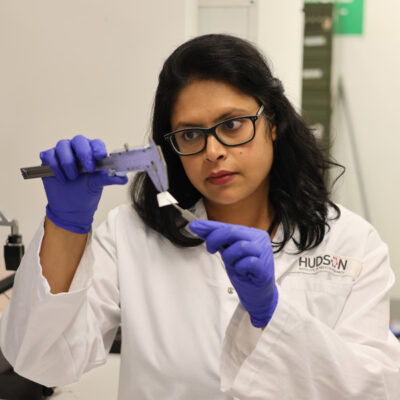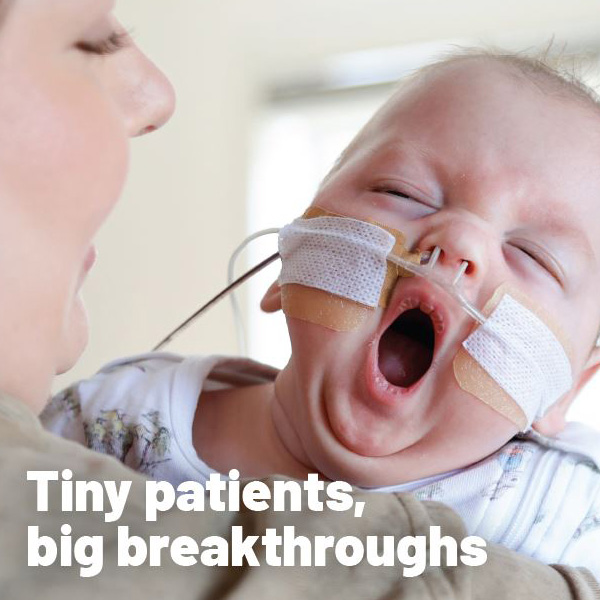Pelvic organ prolapse treatment closer
By Hudson Institute communications
A revolutionary technology to treat pelvic organ prolapse is one step closer after the latest results from a Hudson Institute study.

In 2018, a team led by Dr Shayanti Mukherjee designed new degradable meshes using nanotechnology for pelvic organ prolapse—POP. The team observed the meshes—Nanomesh—worked better when implanted with mesenchymal stem cells derived from the endometrium (eMSCs).
A study recently published in Frontiers in Pharmocology has investigated for the first time, at a molecular level, the foreign body response to Nanomesh when combined with eMSCs.
First author, Dr Mukherjee said the study examined more than 50 gene expression profiles to understand the key players enabling superior performance of Nanomesh when combined with eMSCs.
“For meshes to perform well, the foreign body response to implantation must be controlled and eventually, promote the formation of new tissue and blood vessels. There should also be a higher anti-inflammatory response and a lower low pro-inflammatory response,” Dr Mukherjee said.
“In this study, we found that several genes associated with these ideal processes occurred in the presence of eMSCs and Nanomesh,” Dr Mukherjee said.
Several genes associated with matrix regulation, healing and blood vessel formulation were upregulated. Meanwhile, genes associated with pro-inflammatory responses were down regulated. As a result, there was better tissue integration and more blood vessels in and around the meshes after six weeks.
“Degradable meshes with nanostructured design can be of more therapeutic value when combined with stem cells such as eMSCs,” Dr Mukherjee said. “This bioengineered construct triggers optimal responses, and the meshes are likely to better integrate with tissues. This will help overcome the current hurdles in POP treatment.”
“Our group led by Professor Caroline Gargett leads the world in cell-based nanostructured mesh design for prolapse treatment,” Dr Mukherjee said. “This study’s findings will help all scientists to understand how material design impacts the processes in the body.”
Co-author Dr Saeedeh Darzi said, “Millions of women are waiting for a safe and effective therapy for POP. Our research provides a significant understanding into how the body deals with meshes once they are implanted, and how the foreign body response can be modulated using nanotechnology and stem cell therapy. Without this understanding, it is not possible to take new treatments into the clinic.”
Transvaginal meshes for the treatment of pelvic organ prolapse have been associated with severe adverse events and have been banned for clinical use in many countries.
Meshes for POP treatment in Australia were banned in 2017, mainly due to the undesirable foreign body response to synthetic non-degradable meshes. Therefore, there are very few reliable treatment options for POP.
Regulatory bodies in several countries, including the Australian TGA and US FDA, have indicated the need for research into better treatment strategies.
What is Pelvic Organ Prolapse (POP)?
Pelvic organ prolapse develops when tissues, pelvic floor muscles and ligaments that support the pelvic organs (bladder, uterus and bowel), become damaged, usually in childbirth, causing organs to shift or ‘drop’ into the vagina or even outside the body. This can lead to debilitating symptoms, including poor bladder or bowel control and pain during sex.
The condition can be exacerbated by age, ethnicity, multiple births, obesity and family genetics. Menopause also has an effect. One in two postmenopausal women who have had children will experience POP, compared to one in four generally. Up to a third of women with POP require multiple treatments in their lifetime.
This research was supported by | Science and Industry Endowment Fund (SIEF), and NHMRC
In this article
About Hudson Institute
Hudson Institute’ s research programs deliver in three areas of medical need – inflammation, cancer, women’s and newborn health. More
Hudson News
Get the inside view on discoveries and patient stories
“Thank you Hudson Institute researchers. Your work brings such hope to all women with ovarian cancer knowing that potentially women in the future won't have to go through what we have!”







